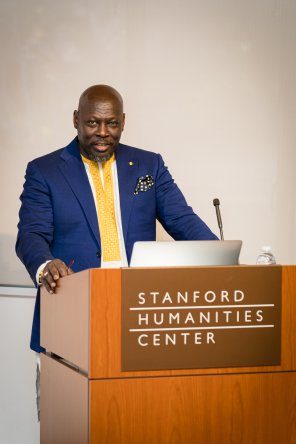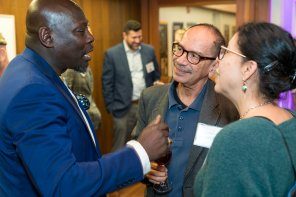The Stories That Have Shaped Ato Quayson's Life and Research

The stories that English professor Ato Quayson tells, studies, and hears are the foundation of what he calls “the architecture of my mind.”
“Ihave an anecdote about that,” said Ato Quayson, professor of English in Stanford’s School of Humanities and Sciences. This statement comes as no surprise to those who know him, as stories are integral to Quayson’s life and work—which spans a wide variety of pursuits from Greek tragedy and postcolonial literature to the diaspora and interdisciplinary urban studies.

Every one of his intellectual pursuits or meaningful chapters is accompanied by a compelling anecdote—from the African diplomat father who told him stories as a child to the Indian grocer who called him “brother.” The stories he tells, studies, and hears are the foundation of what he calls “the architecture of my mind.”
A childhood inspired by words
Quayson, who was born and raised in Ghana, said that like most literary scholars, he grew up loving to read. “My father had been a diplomat and was a very voracious reader of everything including newspapers, refrigerator manuals, Shakespeare, and Buddhist texts,” he said. “He was also a great oral storyteller. Even though several of the stories were repeated, he always said that it was a disrespect to the story to retell it the same way.”
Quayson’s mother, a trader at the local market, also shared stories. He said hers were of the city, often told in rumors and gossip. “This very fertile childhood led me to identify with characters in novels and storylines very early,” he said. “I grew up with this idea of the anecdote, the story as an available hook for various life lessons.”
Pursuing that early passion took Quayson from Accra, Ghana, to the University of Cambridge, where he earned his doctorate in Nigerian literature and went on to join the faculty and lead the African Studies Center.
While he was at Cambridge University, a conversation with a student focused his attention on his nascent interest in disability studies, leading him to write Aesthetic Nervousness: Disability and the Crisis of Representation. “A student asked me why all the novels I had set for discussion in class had disabled characters in them. I hadn’t noticed and so went back to re-read all the texts carefully and, to my utter surprise, discovered that she was completely right,” Quayson said. “The book I wrote was a way of addressing what was clearly a form of critical blindness to a feature of literature that is pervasive in every culture.”
At Cambridge, he also studied and wrote about post-colonial literature and taught courses on Greek tragedy, subjects that he has returned to throughout his career, most recently in a course he’s offering this spring.
The pull of diaspora studies
It was a chance encounter with a local grocer that helped inspire Quayson to pursue diaspora studies. “One fine afternoon, I go to this local market run by three generations of Indian men, and it's the grandad who is there. We're chatting heartily, calling each other ‘my brother, my brother’ and sharing stories about the coldness of Britain. Then, in a rush of fellow-feeling, I piped up and asked him, ‘So, how often do you go back home to India?’ He looked at me completely askance and said, ‘I've never been there before.’ Me, now completely taken aback, ‘Oh! So where do you come from?’ ‘Kenya’,” he replied,” said Quayson, laughing. “I was shocked.”
Later, Quayson said he learned that Britain’s indentured labor policy brought Indians to East Africa from the 1880s to the 1920s, most of whom were men. When the policy was ended, the men were encouraged to create a community by bringing their wives from home or marrying women already in East Africa. “These people now feel themselves to be African. The grocer and I were calling each other, ‘my brother, my brother’ because it was literally true. He was my brother from the same continent. That was the trigger for my interest in diaspora studies. For a long time afterward, I kept thinking, ‘So who is really an African?’"
Quayson was examining that topic and others related to diaspora populations when he became the founding director of the Center for Diaspora and Transnational Studies at the University of Toronto. He went on to run the center for 12 years.
Understanding urban landscapes
Studying diaspora populations and how they congregate in urban areas led to the next chapter in Quayson’s career—urban studies. His book Oxford St., Accra: City Life, the Itineraries of Transnationalism (Duke University Press, 2014) explores the city he grew up in and the place he first fell in love with stories by retelling the history of the city through one street.
The book highlights Quayson’s interdisciplinary approach to understanding the complexities of the Accra community, by using sociological, literary, and architectural perspectives. “For instance, people honk at traffic lights in Accra. Why is this? Well, culturally, crossroads are where spirits converge,” he said. “The honking dispels the spirits.” After joining the Stanford faculty last fall, Quayson taught City, Space, Literature in Stanford’s Urban Studies program using literature and film to examine space, representation, and the urban in various cities around the world.
A conversation at a conference with the editor of a series called Urban Chic, published by Intellect Books and the University of Chicago Press, led Quayson to another Accra project. “They had Vienna Chic, Montréal Chic, L.A. Chic, and Berliner Chic. So, I approached her and said, ‘Why don't you have any African city in there?’ It was a simple question. We're also stylish.” Quayson said. “She laughed and said, ‘Okay, let's go.’ So, I ran back and told my wife, ‘You're the fashionable one. Let’s co-write this book.’”
The book, Accra Chic: A Locational History of Fashion in Accra, which is scheduled for release in 2022, is co-authored by Quayson’s wife, Grace Toléqué, the program officer at the Stanford Institute for Diversity in the Arts. Toléqué is also a jewelry designer whose work incorporates values of African body ornamentation.
At home among the trees
Quayson already has anecdotes to share about his new environment at Stanford. “I love trees,” he explained. “So when I arrived on campus I asked my colleagues here, ‘Who is in charge of the trees?’ They put me in touch with the university arborist, Michael Gladden, and he very generously offered to take me on walking tours of Stanford and its trees. I call him my tree rabbi.”

That is just one of the many connections Quayson has already made on campus. Invited to give the Humanities Center’s inaugural “1891 Lecture,” named for the year the university and a humanities cohort were founded, Quayson delivered an impassioned talk on “Interdisciplinarity and Interpretation.” Quayson argued that by bringing in scholars from different disciplines, researchers can extend both the reach and impact of their work as well as the scale of the questions they are able to tackle.
Toward the end of his talk, Quayson noted the importance of masks used in ritual African dances. He then shared with the lecture audience a short, poetic anecdote inspired by the renowned Nigerian writer Chinua Achebe that concisely explains something fundamental about himself, his commitment to using a variety of lenses to examine the world, and his desire to delve deeply into so many different parts of it. “The world is like a mask dancing. You can’t engage with it by standing in one place. You have to dance, too.”
BY SANDRA FEDER
Ato Quayson is featured in a spotlight article by Stanford School of Humanities and Sciences